Cross-domain pedestrian re-identification method and system based on three stages
A pedestrian re-identification, three-stage technology, applied in the field of cross-domain pedestrian re-identification, can solve the problems of low accuracy of cross-domain pedestrian re-identification, high error rate of false labels, and reduce the cross-mirror discrimination ability of the model, so as to improve domain adaptability and cross-camera capabilities, narrowing the difference in feature distribution, and reducing the effect of fitting
- Summary
- Abstract
- Description
- Claims
- Application Information
AI Technical Summary
Problems solved by technology
Method used
Image
Examples
Embodiment 1
[0037] See attached Figure 1-2 As shown, this embodiment discloses a three-stage cross-domain pedestrian re-identification method, including:
[0038] Build a domain adaptive network for pre-training, and define cross-entropy loss, triplet loss and domain adaptive loss as the network loss function, the purpose is to obtain a feature extractor with classification capabilities and cross-domain cross-mirror capabilities;
[0039] Obtain the source domain training set and target domain training set images and input them into the domain adaptive network, where the source domain images are labeled and the target domain images are not labeled, and the source domain images and their labels are used to train the basic pedestrian discrimination ability of the domain adaptive network , while the target domain image combined with the source domain image is used to train the domain adaptability of the network, input the domain adaptive network, calculate the cross entropy loss, triplet lo...
PUM
 Login to View More
Login to View More Abstract
Description
Claims
Application Information
 Login to View More
Login to View More - R&D
- Intellectual Property
- Life Sciences
- Materials
- Tech Scout
- Unparalleled Data Quality
- Higher Quality Content
- 60% Fewer Hallucinations
Browse by: Latest US Patents, China's latest patents, Technical Efficacy Thesaurus, Application Domain, Technology Topic, Popular Technical Reports.
© 2025 PatSnap. All rights reserved.Legal|Privacy policy|Modern Slavery Act Transparency Statement|Sitemap|About US| Contact US: help@patsnap.com



